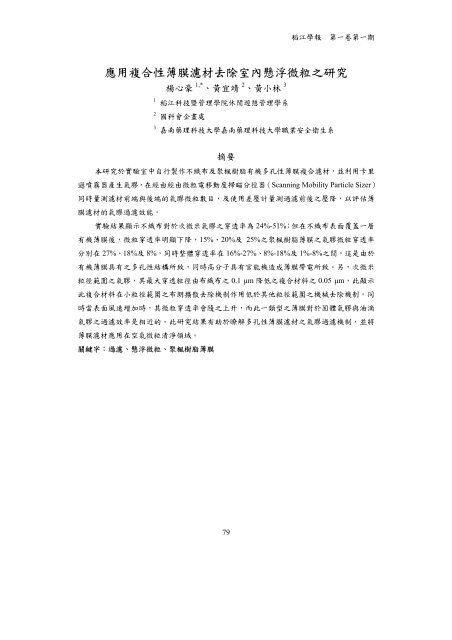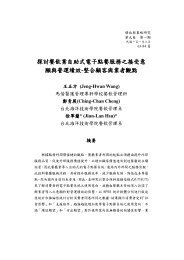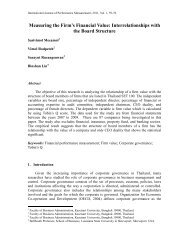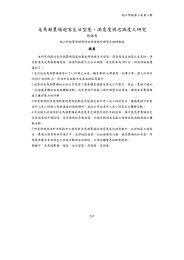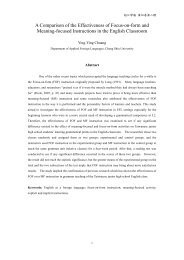æç¨è¤åæ§èè濾æå»é¤å®¤å §æ¸æµ®å¾®ç²ä¹ç 究 - ç 究ç¼å±è - 稻æ±ç§æ ...
æç¨è¤åæ§èè濾æå»é¤å®¤å §æ¸æµ®å¾®ç²ä¹ç 究 - ç 究ç¼å±è - 稻æ±ç§æ ...
æç¨è¤åæ§èè濾æå»é¤å®¤å §æ¸æµ®å¾®ç²ä¹ç 究 - ç 究ç¼å±è - 稻æ±ç§æ ...
You also want an ePaper? Increase the reach of your titles
YUMPU automatically turns print PDFs into web optimized ePapers that Google loves.
濾 粒 <br />
1,* 靖<br />
2 林<br />
1 理 理 <br />
2 <br />
3 理 理 <br />
3<br />
<br />
行 不 濾 利 里<br />
粒 度 Scanning Mobility Particle Sizer<br />
量 濾 粒 數 量 濾 降 <br />
濾 濾 <br />
不 率 24%-51% 不 <br />
粒 率 降 15%20% 25% 粒 率<br />
27%18% 8% 率 16%-27%8%-18% 1%-8%<br />
<br />
粒 粒 0.1 µm 降 料 0.05 µm<br />
料 粒 朗 粒 <br />
粒 率 類 <br />
濾 率 濾 濾 <br />
濾 粒 領 <br />
濾 粒 <br />
79
Removal of Indoor Particulates by using the<br />
Polysulfone-Nonwoven Composite membrane filters<br />
Shinhao Yang 1,* , Yi-Chin Huang 2 , Hsiao-Lin Huang 3<br />
1 Department of Leisure and Recreation Management, Toko University<br />
2 Planning and Evaluation Division, National Science Council<br />
3 Department of Occupational Safety and Health, Chia Nan University of Pharmacy & Science<br />
Abstract<br />
Filtration is one of the most effective and reliable methods for the collection of small size<br />
particulate matters from gas stream. The polysulfone-nonwoven composite membrane filter made<br />
from porous organic membrane and nonwoven matrix was used to study the filtration efficiency<br />
of aerosols in this study. Polydisperse aerosols were generated from a Collison Atomizer. The<br />
aerosols were accounted by Scanning Mobility Particle Sizer and the pressure gradient was<br />
measured by the pressure transducers. Thereafter, the filtration efficiency of the composite filter<br />
was determined by the difference of the numbers of the aerosols and the difference of pressure<br />
after filtration.<br />
The results showed that the aerosol penetration rates of nonwoven matrix were ranged from<br />
24% to 51%. However, the aerosol penetration rates decreased significantly after coating porous<br />
organic polysulfone membrane on nonwoven matrix. The aerosol penetration rates of the three<br />
composite filters coating with the polysulfone concentrations of 15 wt%, 20 wt%, and 25 wt%,<br />
respectively, were 27%, 18%, and 8%, respectively. The overall aerosol penetration rates of the<br />
three composite filters were 16%~27%, 8%~18%, and 1%~8%, respectively. It indicated that the<br />
performance of the composite filters was better than that of nonwoven matrix filters owing to<br />
their capability of trapping the aerosols by the porous structure and attracting the aerosols by the<br />
positive charge on the surface of polysulfone membrane. The most penetration particle size<br />
(MPPS) of aerosols shifted from 0.1 µm to 0.05 µm after coating polysulfone membrane on<br />
nonwoven matrix. The results presented that the effect of Brownian diffusion in removing small<br />
size of aerosols was reduced in the composite filters. Additionally, it found that the aerosol<br />
penetration rates of the composite filters for solid and oily aerosols increased with increasing<br />
surface velocity. This study could help us to understand the filtration mechanism of the<br />
composite filters, and furthermore the composite filters can be applied to the the field of aerosol<br />
removal in the future.<br />
Keywords: Filtration; suspended particulates; polysulfone-nonwoven composite membrane<br />
filter<br />
80
1. <br />
量 都 類 都 <br />
度 90%<br />
六 不 良 66.8%<br />
(1991) 87.2%(Indoor<br />
Environment)7.2% 5.6%(Outdoor Environment)<br />
(Lance, 1996) 來 (Indoor Air Quality, IAQ)<br />
粒 來 粒 <br />
粒 不 良 <br />
益 來 粒 <br />
類 濾 來 <br />
粒 濾 來 說 濾 濾 <br />
(fibrous)(fabric)(membrane) 濾 度 <br />
度 濾 不 <br />
濾 來 行 濾 年 <br />
濾 濾 濾 <br />
濾 兩 Nuclepore <br />
(polycarbonate pore filter) 列 行 不 洞 <br />
濾 濾 濾 濾 來 <br />
粒 (Cohen and Hering, 1995)<br />
濾 濾 不 濾 Nuclepore <br />
行 濾 濾 Spurny et al. (1969) 5 µm <br />
(Nuclepore ) 5cm/sec 行 濾 <br />
粒 0.05 µm 易 粒 Spurny et al. (1964) 濾 濾 <br />
沈 粒 Montassier et al. (1996) <br />
Nuclepore 行 率 MF 濾 流<br />
量 率 行 (1999)<br />
濾 行 <br />
濾 濾 濾 度 <br />
粒 不 Larbot et al. (2003) 利 行 <br />
度 兩 烈 濾 率 度 降 NaCl DOP<br />
粒 率 HEPA ULPA 濾 來 <br />
濾 不 不 離 <br />
81
力 濾 度 利 來 濾 <br />
PSF (Polysulfone) 1.24<br />
率 80%-90% 度 零 100 160<br />
度 度 (18.6 kg-cm/cm ) 175<br />
度 FDA<br />
行 <br />
行 奈 粒 濾 濾 <br />
2. <br />
<br />
1. 行 理 濾 濾 <br />
濾 <br />
2. 不 理 度 粒 率 <br />
3. 不 粒 粒 率<br />
4. 不 粒 率 <br />
3. <br />
3.1 濾 理 論<br />
濾 說 濾 粒 率 <br />
率 Single-Fiber Efficiency 濾 率 (Wang, 2001)Fiber<br />
流 粒 數 理 論 <br />
粒 數 率 (Hinds, 1982) 利 量 <br />
率 <br />
πd<br />
f<br />
( 1−α) ln P<br />
E = −<br />
(1)<br />
∑<br />
4Lα<br />
<br />
E ∑ 率<br />
d f <br />
α 濾 率<br />
L 濾 度<br />
P 率<br />
理 論 不 濾 立 率 不<br />
82
濾 Lathrache, 1987<br />
E Σ 1-1- ED 1-E IR 1-E I 1-E G 1-E O 1-E C 1- E IM <br />
=1-1-E m 1-E O 1-E C (2)<br />
沈 E D diffusion depositionE ID direct interception<br />
沈 E I impaction deposition 力 沈 E G gravitational settling<br />
力 E m mechanical capture force 力 E O <br />
dielectrophoretic force 倫 力 E C columbic force 力 E IM image force<br />
力 E E electrostatic capture force <br />
3.2 濾 類<br />
濾 polysulfone (Udel P-3500,<br />
Amoco Performance Products Inc.) NMP (N-methyl -2-pyrrolidinone)<br />
不 NMP 來 不 <br />
度 來 不 濾 15%20%25% 理 論 度 <br />
洞 不 洞 濾 <br />
3.3 粒 <br />
NaClDEHS<br />
利 里 (Collison Atomizer, Model 3076, TSI Inc) 粒 <br />
粒 (silica gel) 粒 <br />
NaCl 數 粒 0.080 µm GSD 1.614 數 粒 0.180<br />
µm GSD 1.609 粒 流 Kr-85 Neutralizer, Model<br />
3077, TSI Inc 粒 粒 粒 <br />
利 Aerosol Electrometer, Model 3068A, TSI Inc 流 <br />
<br />
3.4 濾 率 量 <br />
83
Compressed,<br />
Dry Air<br />
Diffusion<br />
Dryer<br />
Diluted<br />
Air<br />
Kr 85<br />
Aerosol<br />
Electrometer<br />
Air Supply<br />
System<br />
Collison<br />
Atomizer<br />
Filter<br />
Holder<br />
DMA<br />
Pump<br />
Pressure<br />
Gage<br />
PC<br />
Flow<br />
Meter<br />
SMPS System<br />
CPC, 3022<br />
1<br />
粒 率 量 濾 粒 度 SMPS,<br />
Scanning Mobility Particle Sizer, Model 3934, TSI IncPressure Gage, Model 2000,<br />
Dwyer Instruments Inc 流 量 濾 流 濾 <br />
量 濾 粒 度 粒 率 利<br />
量 量 濾 濾 降 利 流 濾 <br />
流 流 量 (0.05 0.1 m/s) 1 <br />
<br />
4. 論<br />
4.1 不 率<br />
2 利 NaCl 粒 0.1 m/s 不 濾 <br />
粒 率 不 濾 理 行 <br />
量 粒 率 不 <br />
粒 0.1 µm 率 51% 粒 率 <br />
24%-51% 濾 粒 0.3 µm <br />
84
濾 粒 0.1 µm 不 <br />
利 來 量 <br />
不 3.1×10 3 V/m<br />
100<br />
90<br />
Nonwoven<br />
80<br />
Aerosol Penetration (%)<br />
70<br />
60<br />
50<br />
40<br />
30<br />
20<br />
10<br />
0<br />
10 -2 10 -1 10 0<br />
Aerosol Size (µm)<br />
2 不 濾 0.1 cm/s 粒 率<br />
4.2 濾 率<br />
3 利 NaCl 粒 0.1 m/s 15%<br />
濾 粒 率 粒 0.05-0.06 µm 率 <br />
27% 率 16%-27% 不 <br />
粒 率 降 若 0.3 µm 粒 來 15%<br />
率 來 不 率 50%<br />
降 <br />
度 量 15%<br />
1.9×104 V/m 不 <br />
<br />
<br />
85
100<br />
90<br />
Polysulfone 15%<br />
80<br />
Aerosol Penetration (%)<br />
70<br />
60<br />
50<br />
40<br />
30<br />
20<br />
10<br />
0<br />
10 -2 10 -1 10 0<br />
Aerosol Size (µm)<br />
3 濾 0.1 cm/s 粒 率<br />
4.3 不 度 濾 率<br />
4 利 NaCl 粒 0.1 m/s 15%20% 25%<br />
濾 粒 率 不 度 理 濾<br />
粒 0.05-0.06 µm 率 27%18% 8%<br />
率 16%-27%8%-18% 1%-8% 理 度 便 粒 率<br />
降 量 降 0.1 m/s 15%20%<br />
25% 降 1520 24 cmH 2 0 理 度 <br />
降 度 洞 <br />
降 洞 粒 率 降 更 量 <br />
15%20% 25% 1.9×10 4 V/m<br />
2.3×10 4 V/m 2.9×10 4 V/m 更 度 <br />
更 率 度 降 <br />
86
80<br />
Aerosol Penetration (%)<br />
70<br />
60<br />
50<br />
40<br />
30<br />
20<br />
15% Polysulfone Membrance<br />
20% Polysulfone Membrance<br />
25% Polysulfone Membrance<br />
10<br />
0<br />
10 -2 10 -1 10 0<br />
Aerosol Size (µm)<br />
415%20% 25% 濾 0.1 cm/s 粒 率<br />
4.4 不 濾 率 <br />
100<br />
90<br />
15% Polysulfone Membrance<br />
Aerosol Penetration (%)<br />
80<br />
70<br />
60<br />
50<br />
40<br />
30<br />
20<br />
0.1 m/s<br />
0.05 m/s<br />
10<br />
0<br />
10 -2 10 -1 10 0<br />
Aerosol Size (µm)<br />
515% 濾 0.05 0.1 cm/s 粒 率<br />
5 利 NaCl 粒 0.05 0.1 m/s 15%<br />
87
粒 率 0.05 m/s 率 10%-20%<br />
0.1 m/s 粒 率 粒 濾 濾<br />
力 力 降 兩 力 <br />
力 粒 <br />
力 降 <br />
4.5 不 類 濾 率 <br />
80<br />
70<br />
With NaCl Soild Aerosol<br />
With DEHS Oil Aerosol<br />
Aerosol Penetration (%)<br />
60<br />
50<br />
40<br />
30<br />
20<br />
10<br />
0<br />
10 -2 10 -1 10 0<br />
Aerosol Size (µm)<br />
615% 濾 0.1 cm/s NaCl DEHS 粒 率<br />
6 利 NaCl 粒 DEHS 粒 0.1 m/s <br />
15% 粒 率 兩 率 16%-27%<br />
類 濾 <br />
濾 濾 略 [9] 不 <br />
<br />
5. 論<br />
1. 不 粒 0.1 µm 率 51% 粒<br />
率 24%-51%<br />
2. 15% 粒 0.05-0.06 µm 率 27%<br />
88
率 16%-27% 1.9×104 V/m<br />
3. 不 粒 率 降<br />
降 <br />
度 不 <br />
4. 理 度 洞 更 <br />
率 度 降 <br />
5. 濾 粒 率 <br />
6. 濾 <br />
參 <br />
(1999) 濾 年 <br />
北 <br />
良 (1991) , EPA-80-F101-09-24<br />
行 <br />
Cohen, B. S., & Hering, S. V. (1995). Air Sampling Instruments for Evaluation of Atmospheric<br />
Contaminants. 8th Edition, ACGIG, Cincinnati, Ohio.<br />
Hind, W. C. (1982). Aerosol Technology, John Wiley and Son, New York.<br />
Lance, W. (1996). Indoor Particles: A Review, Air and Waste Manage. Assoc. 46, 98-126.<br />
Larbot, A., Bertrand, M., Marre, S., Prouzet, E. (2003). Performance of Ceramic Filters for Air<br />
Purification. Sep. Puri. Technol. 32, 81-85.<br />
Lathrache, R., & Fissan, H. J. (1987). Enhancement of Particle Deposition in Filters due to<br />
Electrostatic Effects. Filtration and Separation, 24(6), 418-422.<br />
Martin, S. B., & Moyer, E. S. (2000). Electrostatic Respirator Filter Media: Filter Efficiency and<br />
Most Penetrating Particle Size Effects, Appl. Occup. Environ. Hyg. 15, 609-617.<br />
Montassier, N., Dupin, L., Boulaud, D. (1996). Experimental Study on the Collection Efficiency<br />
of Membrane Filters. J. Aerosol Sci. 27(Suppl. 1), S637-S638.<br />
Spurny, K. R., Lodge, Jr., J. P., Frank, E. R., Sheesley, D. C. (1969). Aerosol Filtration by Means<br />
of Nuclepore Filters: Structural and Filtration properties. Environ. Sci. Technol. 10, 453-464.<br />
Spurny, K., & Pich, J. (1964). The Separation of Aerosol Particles by Means of Membrane Filters<br />
by Diffusion and Inertial Impaction. Int. J. Air Wat. Pollut. 8, 193.<br />
Wang, C. S. (2001). Electrostatic Forces in Fibrous Filters-A Review, Powder Technology. 118,<br />
166-170.<br />
89


